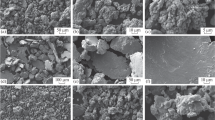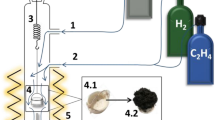Abstract
Carbon nanomaterials are being actively implemented in various energy fields, including hydrogen. One of the main problems for the development and implementation of metal hydride technologies is the low thermal conductivity of fine powders of hydride-forming materials. This feature, given the rather high values of the heat of reaction of intermetallic compounds with hydrogen, leads to an increase in the cost of the design of reactors with metal hydrides and heat exchangers, which reduces the competitiveness of hydrogen-based technologies. One of the most promising ways of solving this problem today is the formation of compacts from powders of metal hydrides with additives that increase thermal conductivity by pressing. We investigated compacts based on intermetallic compounds AB5-type composition LaNi4.4Al0.3Fe0.3 prepared using various techniques, and a comparison of their properties with the free filling of this metal hydride was carried out. Carbon nanofibers and nickel-based foam were used as additives to improve the thermal conductivity of the compacts. The main methods for studying the properties of samples were the measurement of the absorption and desorption isotherms of hydrogen in the pressure-composition-temperature coordinates and the temperature inside the samples during their heating and interaction with hydrogen. The compacts showed a noticeable improvement in thermal conductivity, with a slight deterioration in hydrogen sorption properties.


Similar content being viewed by others
REFERENCES
F. S. Tabarov, M. V. Astakhov, A. A. Klimont, A. T. Kalashnik, R. R. Galimzyanov and N. V. Isaeva, Nanotechnol. Russ. 14, 16 (2019). https://doi.org/10.21517/1992-7223-2019-1-2-13-18
M. V. Lototskyy, I. Tolj, L. Pickering, et al., Prog. Nat. Sci. 27, 3 (2017). https://doi.org/10.1016/j.pnsc.2017.01.008
P. Muthukumar, A. Kumar, N. Raju, et al., Int. J. Hydrogen Energy 43, 17753 (2018). https://doi.org/10.1016/j.ijhydene.2018.07.157
J. Colbe, J. Ares, J. Barale, et al., Int. J. Hydrogen Energy 44, 7780 (2019). https://doi.org/10.1016/j.ijhydene.2019.01.104
V. I. Borzenko, D. O. Dunikov, and S. P. Malyshenko, High Temp. 49, 249 (2011). https://doi.org/10.1134/S0018151X11010019
S. S. Mohammadshahi, E. M. Gray, and C. J. Webb, Int. J. Hydrogen Energy 41, 3470 (2016). https://doi.org/10.1016/j.ijhydene.2015.12.079
E. S. Kikkinides, M. C. Georgiadis, and A. K. Stubos, Energy 31, 2426 (2006). https://doi.org/10.1016/j.energy.2005.10.036
V. I. Borzenko, I. A. Romanov, D. O. Dunikov, et al., Int. J. Hydrogen Energy 44, 6086 (2019). https://doi.org/10.1016/j.ijhydene.2019.01.052
P. Rizzi, E. Pinatel, C. Luetto, et al., J. Alloys Compd. 645, S338 (2015). https://doi.org/10.1016/j.jallcom.2014.12.145
A. Chaise, P. de Rango, P. Marty, et al., Int. J. Hydrogen Energy 34, 8589 (2009). https://doi.org/10.1016/j.ijhydene.2009.07.112
A. Khelwal, F. Agresti, G. Capurso, et al., Int. J. Hydrogen Energy 35, 3565 (2010). https://doi.org/10.1016/j.ijhydene.2010.01.076
J. Jepsen, C. Milanese, A. Girella, et al., Int. J. Hydrogen Energy 38, 8357 (2013). https://doi.org/10.1016/j.ijhydene.2013.04.090
Funding
The study was financed by the Russian Science Foundation (grant no. 17-19-01738).
Author information
Authors and Affiliations
Corresponding author
Rights and permissions
About this article
Cite this article
Romanov, I.A., Borzenko, V.I. & Kazakov, A.N. Use of Carbon Nano Fibers in the Production of Metal Hydride Compacts. Nanotechnol Russia 15, 314–318 (2020). https://doi.org/10.1134/S1995078020030118
Received:
Revised:
Accepted:
Published:
Issue Date:
DOI: https://doi.org/10.1134/S1995078020030118




